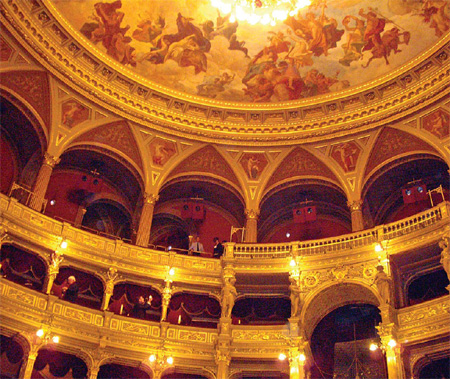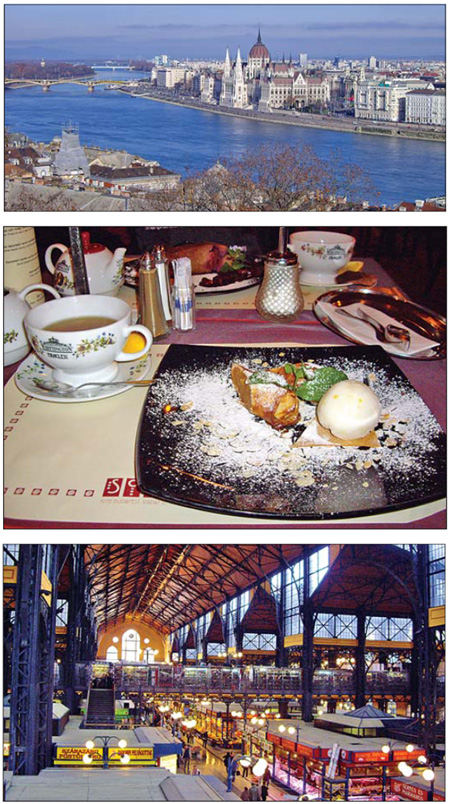Hungarian Rhapsodies
Updated: 2011-12-04 08:10
By Rebecca Lo(China Daily)
|
|||||||
|
The Hungarian State Opera House is decked out in a Neo-Renaissance and Neo-Baroque style with excellent acoustics from every corner. Photos by Rebecca Lo / China Daily |
|
Top: The Parliament Building across the Danube. Middle: Pear strudel at Soul Cafe. Above: The Great Market Hall is packed with fresh produce and cooked food stalls. |

For Rebecca Lo, the old-world charms of Budapest come together in a memorable soak in a Neo-Baroque bath surrounded by falling snow.
I love baths. For years, I sought out great soaks while on holidays - and this quest has taken me from the onsens of Hakone to the buoyant waters of the Dead Sea. Yet nothing was quite as romantic or relaxing as the giant thermal pool under the shelter of glowing white marble statues at Szechenyi Bath and Spa in Budapest's City Park.
The temperature hovered around freezing and a light flurry of snow gave the setting a fairy-tale feel as I floated in warm waters kept a few degrees above body temperature.
Mist rose from the surface of the three pools into the night sky. Men, both young and old, letting it all hang out in skimpy Speedos clustered around intense games of chess played on top of stair railings.
In the center of one pool, a current propels bathers around in a ricochet of flailing limbs.
Europe's largest medicinal bath complex also includes 15 smaller pools, complemented by sauna and steam rooms ranging from steamy to sweltering. The atmosphere is part spa and all fun.
Scratch anywhere beneath Hungary, it is said, and you will find artesian wells. Many of Budapest's thermal baths date back to the glory days of the Austro-Hungarian empire. Some, such as Rudas, Kirly and Lukcs, go back even further, to when the city was part of the Ottoman empire. Others, such as the resplendent Gellrt with its separate male and female soaking areas, are housed inside swank Art Nouveau style hotels.
The pools serve as a window into the city itself, as you can see all walks of life within them waiting to be discovered as you peel back their many historical layers.
At this time of the year, Budapest is home to one of Europe's most lively Christmas markets.
Voromarty Square, situated at the end of the second oldest metro line in Europe after London, morphs into a colorful outdoor market in late November.
Armed with steaming mugs of mulled wine, visitors stroll among the dozens of stalls to watch iron accessories being forged or marvel over handmade ceramics and intricate jewelry from all over the region. On stage are gypsy dancing and traditional folk songs that will encourage toe tapping, while the aroma of wood-burning fires under a huge pot of aromatic stew makes mouths water.
The Voromarty Christmas market is a great place to hobnob with locals while indulging in authentic Hungarian dishes and shopping for unique souvenirs.
You can also satisfy cravings for local delicacies at the Great Market Hall.
Built in 1896 and featuring a brightly tiled roof, this three-story building with lofty trussed ceilings is packed with fresh produce and cooked-food stalls. Pick up some spicy paprika or a bottle of sweet Tokay, the Hungarian dessert wine that goes fabulously with foie gras.
Hungarians consume almost as much foie gras as the French, and it can be found throughout the market in various forms including conveniently packaged pates for gift-giving. On the second level, there are numerous stands for a quick and casual bite, with the lngos outlet a popular place for a light lunch. Essentially deep fried flat bread, lngos are a cross between a doughnut and a pizza, and can be topped with a choice of cheese, sour cream, ketchup and ham or sausage.
Budapest's coffee house culture is known for being eclectic, warm and casual - and everyone has his favorite corner hang out. With homey environments and live music, it is no wonder they were the haunts of legendary Hungarian artists, writers and philosophers who nursed their coffee while plotting rebellions more than a century ago.
They also serve some of the city's best dishes, and not be missed is the caf version of spicy red goulash with tender chunks of beef, dumplings, schnitzel, stuffed cabbage and chicken paprika - along with honey-filled cakes and apple strudel with a side of vanilla ice cream. Soul Caf, Central Coffee House and Gerloczy Caf are just a trio to sample for freshly brewed coffee or more substantial fare.
After tummies are satisfied, shimmy into that little black number for a night out at the Hungarian State Opera House. It almost doesn't matter what is on stage - the real drama are the glorious dome ceiling frescoes, the gilded mouldings, the ornate tiered balconies and the red velvet seats in one of Europe's most splendid shrines to art and culture.
Opened in 1884, it is decked out in a Neo-Renaissance and Neo-Baroque style with excellent acoustics for every corner in the house. Enjoy a glass of wine during intermission on the large terrace overlooking Andrassy, the city's leafy main boulevard lined with shops that rival the Champs Elysees. Returning to your seat, imagine Gustav Mahler conducting the orchestra 125 years ago as director of the Royal Opera. Ogle at a cherub floating high above.
Further down Andrassy is another building that houses history of a decidedly different nature.
Dubbed the House of Terror, 60 Andrassy Boulevard is a harrowing museum depicting the time when the site was the headquarters for the Nazis and the Communists during and after World War II.
Along with a full size Russian tank ominously greeting visitors upon entry, the site's original torture chambers were replicated to give visitors a sense of their bone-chilling purposes. One of the museum's most compelling displays is a three-minute video played during an excruciatingly slow elevator ride down to the bowels of the museum, when a former executioner speaks candidly and without emotion about how he prepares for a kill.
Stepping back out to the bright lights of the street, it is clear to see from the city's buoyant optimism that Budapest has reconciled with its recent past - and is ready to charm the world again.
You may contact the writers at sundayed@chinadaily.com.cn.
(China Daily 12/04/2011 page16)

